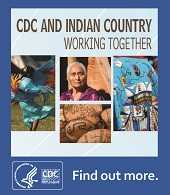Tribal Resources
Chronic Disease Prevention and Health Promotion in Indian Country
Background
American Indians and Alaska Natives are as diverse as the places they come from, with unique cultures, languages, histories, arts, and rituals. Yet all share a deep connection to lifeways that can sustain health and wellness.
While fraught relationships with the US government have compromised lifeways, culture, and health and wellness, American Indians and Alaska Natives have persevered and sustained themselves and much of their cultures. However, poorer health and social outcomes and lower life expectancies than other racial and ethnic groups in the United States are a reality for many American Indians and Alaska Natives.
The Centers for Disease Control and Prevention (CDC) works with and supports American Indian tribes, Alaska Native villages, tribal organizations, and tribal epidemiology centers to promote health, prevent disease, reduce health disparities, and strengthen connections to culture and lifeways that improve health and wellness.
Our Work with Tribes and Tribal Organizations

CDC’s National Center for Chronic Disease Prevention and Health Promotion (NCCDPHP) supports public health approaches to improve the health of American Indians and Alaska Natives through four action areas or domains: epidemiology and surveillance, environmental approaches, health care system interventions, and community programs linked to clinical services. By working with Native people, governments, and organizations, NCCDPHP seeks to support and reinforce healthy behaviors and practices.
NCCDPHP’s largest investment to improve health among American Indians and Alaska Natives is the Good Health and Wellness in Indian Country program. The center makes additional investments to prevent and control cancer and heart disease, and build public health capacity and infrastructure in Indian Country.
Future Directions: Understanding Tribal Health Practices
NCCDPHP is committed to understanding how to address chronic diseases and their risk factors in ways that work for American Indian and Alaska Native people. One way NCCDPHP has worked to develop this understanding is by convening representatives from across Indian Country to identify and describe key activities and practices that keep people well and then incorporate these into its funding opportunities to better support health and well-being in this population.
At the first convening, facilitated by a Native-serving organization, participants listed tribal practices that create or strengthen cultural identity and promote physical, mental, and spiritual well-being for Native nations. Practices were grouped into seven themes, which were presented to the CDC Tribal Advisory Committee. Next steps will include these themes as areas of work in a future funding opportunity announcement.
Resources
- Funding Opportunity Announcement: Building Public Health Infrastructure in Tribal Communities NEW!
- CDC and Indian Country [PDF – 11.5 MB]
- CDC’s Tribal Support Unit
- Good Health and Wellness in Indian Country
- Additional Investments in Indian Country
- A Comprehensive Approach to Good Health and Wellness in Indian Country (DP14-1421PPHF14 funding breakdown)
Publications
Bauer UE, Plescia M. Addressing disparities in the health of American Indian and Alaska Native people: the importance of improved public health data. Am J Public Health. 2014;104(S3):S255-257. PubMed abstract.
Espey DK, Jim MA, Cobb N, Bartholomew M, Becker T, Haverkamp D, Plescia M. Leading causes of death and all-cause mortality in American Indians and Alaska Natives. Am J Public Health. 2014;104(S3):S303-311. PubMed abstract.
Espey DK, Jim MA, Richards TB, Begay C, Haverkamp D, Roberts D. Methods for improving the quality and completeness of mortality data for American Indians and Alaska Natives. Am J Public Health. 2014;104(S3):S286-294. PubMed abstract.
White MC, Espey DK, Swan J, Wiggins CL, Eheman C, Kaur JS. Disparities in cancer mortality and incidence among American Indians and Alaska Natives in the United States. Am J Public Health. 2014;104(S3):S377-387. PubMed abstract.
- Page last reviewed: September 25, 2017
- Page last updated: September 25, 2017
- Content source:



 ShareCompartir
ShareCompartir
